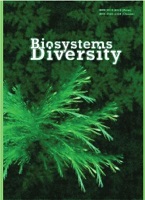Ecological and faunal characteristics of helminths of wetland birds in North-Western Uzbekistan
Ecological and faunal characteristics of helminths of wetland birds in North-Western Uzbekistan
Author(s): I. Arepbaev, F. Akramova, U. Shakarbaev, Z. Yorkulov, A. Mirzayeva, S. Saidova, J. Esonboyev, F. Safarova, K. Saparov, M. Jumanov, Dilmurod AzimovSubject(s): Environmental Geography, Human Ecology, Political Ecology, Environmental interactions
Published by: Дніпропетровський національний університет імені Олеся Гончара
Keywords: fauna; ecology; distribution; wetland birds; molluscs; intermediate hosts; definitive hosts;
Summary/Abstract: The article studies some faunistic features of helminths of wetland birds in the ecological crisis zone in North-Western Uzbekistan. Parasites of wetland birds collected in the basin of the lower reaches of the Amu Darya during the hunting seasons of 2018–2022 were used as material for this work. 500 individuals of birds representing 39 species from 24 genera, 13 families and 9 orders were examined using the parasitological dissection method. The article discusses the distribution and ecology of the helminths in the studied groups of birds. A total of 112 helminth species were identified in the region – 28 species belong to the class Cestoda, the class Trematoda is represented by 57 species, Nematoda – 23 and Acanthocephala – 4 species. 92 species of heminths were identified in the study area for the first time. The work provides original data on the structure of the helminth fauna from 9 orders of wetland birds. Various paths of helminth transmission in the circulation of infection were specified. The researchers identified four ways parasites use to enter their definitive host: helminths penetrate the host’s body when the latter eats other organisms, intermediate or reservoir hosts of helminths, which are part of the definitive’s host’s diet; helminths enter the host as mechanical impurity to food or water; they make active efforts to penetrate their host; helminths are transmitted by the intermediate host when the latter forages on the definitive host. Most of intermediate hosts for representatives of the classCestoda were crustaceans – inhabitants of different types of water bodies; Oligochaeta are also included here as second or reservoir hosts. The development of trematodes occurs with the participation of aquatic molluscs acting as the first intermediate host. Various species of insects, fish, amphibians, reptiles and small mammals were identified as the second hosts. Nematoda use a wider range of intermediate hosts (Oligochaeta, crustaceans, insects – aquatic and terrestrial). Fish and amphibians were registered as the second and reservoir hosts of nematodes. The food chains of individual orders of wetland birds largely determine the composition of helminths parasitising them and are the main factor in the formation of their helminth fauna. These processes undoubtedly occur in time and space under the strict control of environmental factors.
Journal: Biosystems Diversity
- Issue Year: 30/2022
- Issue No: 4
- Page Range: 380-387
- Page Count: 8
- Language: English

